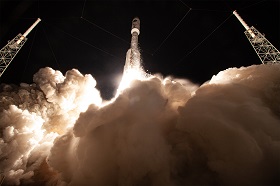Amid the tensions over security in the Euro-Atlantic rising, one remarkable publication of January 2022 has been awarded with inadequate attention. Three years after openly recognizing space as a new operational domain and even after introducing institutional changes to the structure of the Alliance, with the Space Center established in Germany, NATO first articulated its Space Policy, and it did so in a rather comprehensive manner.
With the Space Policy endorsed, NATO gained a feasible plan of how to transform space into the fifth operational domain. This domain may be “activated”, on the one hand, if there are attacks to, from, or within space, and on the other hand, if there is a need to increase the effectiveness of operations in other domains. Thus, there are almost no visible constraints for benefitting from space as the high ground.
The recently shaped path of expanding political and military influence is no doubt a decisive and promising step forward for the Alliance. Still, predictably sooner rather than later the organization will struggle with dividing the financial burden and technical responsibilities among its members. For the global community, especially Russia and China, the opening window of opportunities is less lucrative. Relationships in space are overwhelmed with misconceptions and misunderstandings, suspicions in aggressive intentions and concealing military capabilities behind dual use technologies—all stoking the perpetual security dilemma.
Amid the tensions over security in the Euro-Atlantic rising, one remarkable publication of January 2022 has been awarded with inadequate attention. Three years after openly recognizing space as a new operational domain and even after introducing institutional changes to the structure of the Alliance, with the Space Center established in Germany, NATO first articulated its Space Policy, and it did so in a rather comprehensive manner.
The document consists of five sections, including introduction, reasoning for space considered a threatened environment, principles and tenets guiding the organization’s members, summary of approaches to space and relevant space terminology. While the introductory and closing parts of the Space Policy are formal rather than eye-opening, the essence comes with the in-between paras. Still, some may argue that the starter is also worth mentioning, as lacking an internationally agreed term of “space” authors came up with their own solution. The proposal is to refer to space as “the ‘volume’ beyond the upper limits of airspace”—the definition that may hardly be accepted by the world community due to its vagueness, but it can still be enough to provide the impetus to practical cooperation among nations.
When dwelling on the threats emanating from space, the document bluntly indicates that some international actors—“potential adversaries”—do their best to “threaten Allies’ access to, and freedom to operate in space”. These actors develop both kinetic and non-kinetic means of diversely affecting NATO members’ space assets so that they could undermine the ability of the latter to fulfill their collective security obligations. Notably, the authors do not leave room for contemplation over the list of such potential “troublemakers”—a glance at the below-text footnote specifies that China and Russia (as well as Iran and North Korea) feature on the list.
Existence of unreliable spacefaring nations is deemed dangerous per se. The challenge, however, is also aggravated by a number of long-standing issues, whether legal or tech-related, which have not been resolved so far. Among them is the issue of distinguishing admissible utilization of space systems and the verge of them posing a “threat of force, use of force, armed attack or aggression” (potential prerequisite for invoking Article 5). The Space Policy equally recognizes the problems of allocating attacks to particular nations and mitigating space debris (generated either by anthropogenic or natural accidents). All these factors, the document argues, result in space activities remaining a highly risky venture.
The guiding principles in space seem to be deescalating the pressure of the previous paras. Indeed, they indicate the priority of deterrence and defense policies over offensive posture, confirm NATO’s adherence to the Outer Space Treaty—whether these be provisions on the peaceful use of outer space, prohibition of national appropriation of outer space or obligations on retaining jurisdiction and control over the launched objects. The authors also preventively reject the notion of NATO becoming an autonomous space actor, granting the Alliance with a complementary role in international space affairs. Despite enlisted positive signs, combined with the note on admitting that any space conflict will impact all the users of space, the facade of the document cannot but cause caution.
As illustrated by last decades’ interventions of NATO or its members into “rogue states” as well as by attempts to reverse the course of regional conflicts without UNSC sanction, sweet strains will not necessarily come true to life. While choosing not to advocate for offensive measures in space as for now, NATO may still resort to offensive defense one day if this were regarded to be in “the common interest”. Neither shall addressing the OST alleviate concerns of other actors in space: first, the space law is filled with grey areas, specifically those regarding military aspects; second, there are as many interpretations of the provisions of space law as there are space nations. Agreements drafted in the 1960-1970s were too dependent on the idea of finding middle ground between the interests of rising spacefaring nations—this ultimately meant they were unavoidably premised to be ambiguous in nature. Ultimately, the world community will have to accept the fact that there will be a bunch of interpretations of the same lines. A vivid example has been the reaction of the Russian side on the 2020 U.S. “Executive Order Encouraging International Support for the Recovery and Use of Space Resources”. In a nutshell, it was negative. More importantly, it signaled that addressing the same legal instruments does not entail increased understanding and trust.
Digging deeper into NATO’s approaches to space, the authors distinguish four key responsibilities that the Alliance associates itself with. They include integrating the space factor into the delivery of collective defence and crisis management tasks; conducing political-military consultations on space-related matters; providing space support to the members’ missions; ensuring interoperability between allies’ space products. To implement these roles, it is required to activate efforts in—at least—nine directions, embracing both technological advancements and measures to ensure political and military cohesion.
Generally speaking, the Space Policy is not all about devising brand-new cooperation mechanisms, to which we can assign increasing joint space domain awareness, ensuring interoperability of space capabilities and converging approaches to deterrence, defense and resilience in space. Some of the proposed actions have already been in place—take the envisaged mutual trainings and exercises. For some 25 years, the U.S. has been initiating multiple wargames, the most well-known of which are Schriever games [1]. The latter are popular for three key reasons: wide geographic scope of participants including those from NATO, contribution to the analysis of key patterns of future conflicts in space, attraction of both allied military and commercial partners—all of those are reflected in the current Space Policy. Another example of NATO formalizing its previous experiences is the provision regarding application of space assets for solving other domain tasks. Actually, these were operations that NATO members conducted in the late 1990s till the early 2000s, and they have made the global community think of space as an integral component of military planning. Therefore, it may be assumed that the objective of the document was not only to explore new tracks of cooperation but also to officially accumulate the previous ones under the NATO umbrella, thus adding authority points to the organization.
All in all, with the Space Policy endorsed, NATO gained a feasible plan of how to transform space into the fifth operational domain. This domain may be “activated”, on the one hand, if there are attacks to, from, or within space, and on the other hand, if there is a need to increase the effectiveness of operations in other domains. Thus, there are almost no visible constraints for benefitting from space as the high ground.
The recently shaped path of expanding political and military influence is no doubt a decisive and promising step forward for the Alliance. Still, predictably sooner rather than later the organization will struggle with dividing the financial burden and technical responsibilities among its members. For the global community, especially Russia and China, the opening window of opportunities is less lucrative. Relationships in space are overwhelmed with misconceptions and misunderstandings, suspicions in aggressive intentions and concealing military capabilities behind dual use technologies—all stoking the perpetual security dilemma.
As the recent vote
on “responsible behaviors in space” resolution has shown, there is no unanimity in the vision of steps required to prevent the arms race in space, neither there is confidence in benevolent aspirations of counterparties pushing forward alternative approaches to space security. The newly published Space Policy in this context may only aggravate tensions over the disputed global common. Against the background of the Ukrainian episode, NATO’s overarching space plan comes as another impediment to restoring disrupted security dialogue.
Given these observations, the questions that come to the fore are whether, when and what kind of response will follow on behalf of the designated “adversaries”. It may be quite likely that we may witness strengthening of the “space wing” of Collective Security Treaty Organization as the Alliance’s counterweighting mechanism. However, a symmetrical response is not the only course of action possible.
1. Secure World Foundation. Global Counterspace Capabilities: An Open Source Assessment 2021. p. 140.







